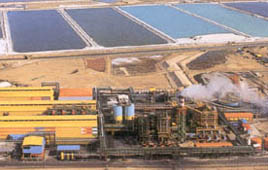
Dead Sea Magnesium Factories (Courtesy: Israel Chemicals Ltd.)
Industry
Israel is today an industrialized country with most of its manufacturing, including many traditional fields, based on intensive and sophisticated research & development and hi-tech processes, tools, and machinery. This is the outcome of very rapid and intensive development.
Today's dynamic, widely diversified industrial sector was developed from small workshops, originally established since the end of the 19th century to manufacture farm implements and process agricultural products. Two incentives brought about the initial transformation of these workshops into more modern factories - the immigration of entrepreneurs and experienced engineers from Germany in the 1930s and the increasing demand for industrial products during World War II (1939-45) as the Allied forces in the region required various commodities, especially clothing and canned foods, and the region needed products that could not be imported from Europe because of the war.
Until the 1970s, traditional industries - such as food processing, textiles and fashion, furniture, fertilizers, pesticides, pharmaceuticals, chemicals, rubber, plastic, and metal products - provided most of the country's industrial output. In that period most resources were directed toward developing agriculture, food production and processing, laying infrastructure, and providing quick employment of many unskilled immigrants.
The next phase of industrialization concentrated on developing and manufacturing arms needed for the defense of the country. It was accelerated because of arms embargoes that endangered the nascent state. The vast investment in aviation and armament industries created new technologies that became the base for Israel's unique hi-tech industries, such as medical devices, electronics, computer software and hardware, telecommunications, etc. In the 1980s, Israelis who worked in the Silicon Valley returned to Israel, opening development centers of multinational companies such as Intel, Microsoft, IBM, and others. In the 1990s a highly skilled immigration of scientists, engineers, technicians, and medical workers from the former Soviet Union enabled the upgrading of Israel's industry to its current level of sophistication, with its array of export products.
Due to its lack of natural resources and raw materials, Israel's one advantage is its highly qualified labor force, scientific institutes, and R&D centers. Today Israeli industry concentrates mostly on manufacturing products with high added value, by developing products based on Israel's own scientific creativity and technological innovation.
Unlike most developed economies, in which the number of persons employed in industry remained stable or diminished during the early 1990s, their number in Israel continues to grow, with more than 25 percent of the industrial workforce employed in hi-tech manufacturing.
In the past two decades, industrial output has made international-level strides in the fields of medical electronics, agro-technology, telecommunications, fine chemicals, computer hardware and software, as well as diamond cutting and polishing. In 2008, the manufacturing industry employed 384,000 persons (among them, the rate of those with higher education was second only to that of the work forces of the US and Holland). There were 11,000 industrial plants that produced an output of over $58 billion - more than half of which was exported. |